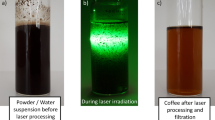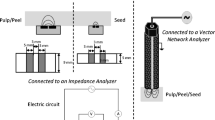Summary
The electron spin resonance (ESR) spectra of coffee display in addition to signals arising from paramagnetic ions (Fe3+, Mn2+) intensive lines nearg=2. These are assigned to free radicals, the number of unpaired spins per gramm amounting to about 1014 to 1015 for unroasted coffee-beans, 1016 for roasted coffee, 1014 for coffee-extract, and 1017 for grounds. By measuring the concentration of free radicals (KFR) in different samples and by observing the change during storage, information has been obtained which concerns the influence of the various technological processes. The concentration of free radicals and its dependence upon time reacts sensitively upon the water content. The increase after roasting can be explained by a first order reaction of formation.
Zusammenfassung
Die Elektronenspinresonanz (ESR)-Spektren von Kaffee zeigen neben Signalen von paramagnetischen Ionen (Fe3+, Mn2+) intensive Linien beig=2. Diese werden freien Radikale zugeordnet, deren Konzentration für Rohkaffee in der Größenordnung 1014 bis 1015 ungepaarte Spins je Gramm liegt, für Röstkaffee bei 1016, für Kaffee-Extrakt bei 1014 und weniger, und für Kaffeesatz bei 1017 Spins/g. Durch Messung der Konzentration freier Radikale (KFR) in verschiedenen Proben und der Änderung während der Lagerung wurden Aussagen über den Einfluß der verschiedenen technologischen Prozesse erhalten. Die KFR und ihr zeitlicher Verlauf reagieren empfindlich auf den Wassergehalt. Die Zunahme der KFR nach dem Rösten kann durch eine Erzeugungsreaktion erster Ordnung erklärt werden.
Similar content being viewed by others
Literatur
O'Meara JP, Truby FK, Shaw TM (1957) Food Research 22:96
Hernandez LC, Rodriguez J, Albis E, Fritsch G (1973) 6th Int. Coll. Coffee Chem. (ASIC), Bogota
Rockland LB (1969) Food Techn 23:1241
Labuza TP, Tannenbaum SR, Karel M (1970) Food Techn 24:543
Acker L (1963) Enzyme activity at low water contents. In: Recents Advances in Food Science, Vol. III Butterworth's, London
Fritsch G, Reymond D (1970) Int J Appl Rad Isotopes 21:329
Wahba IJ, Massey JM (1966) J Polymer Sci 4: A-1, 1759
Fritsch G, Guex M (1971) Proc IMEKO Symp Esztergan, Hungary
Quijano M, Spetel B (1973) 6th Int. Coll. Coffee Chem. (ASIC), Bogota
Rodriguez J, Fritsch G, Diaz J (1975) 7th Int. Coll. Coffee Chem. (ASIC), Hamburg
Sivetz M, Foot HE (1963) Coffee Processing Technology. Vol. 1 The AVI Publishing Comp
Heiss R, Radtke R (1968) Verfahrenstechnik 2:474
Castner T, Newell GS, Holton WC, Slichter CP (1960) J Chem Phys 32:668
Gould ES (1959) Mechanism and Strukture in Organic Chemistry. Henry Holt and Co. Inc., New York
Author information
Authors and Affiliations
Rights and permissions
About this article
Cite this article
Diaz Santanilla, J., Fritsch, G. & Müller-Warmuth, W. Elektronenspinresonanz-Experimente an Roh- und Röstkaffeeproben. Z Lebensm Unters Forch 172, 81–86 (1981). https://doi.org/10.1007/BF01042408
Received:
Accepted:
Issue Date:
DOI: https://doi.org/10.1007/BF01042408




